
Andrew DeLaRosa |
Robert Hines |

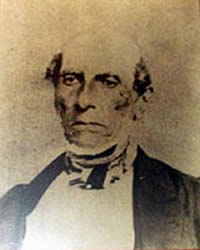
C
astroville, often called the “Little Alsace” of Texas, is a small town located in Medina County, along-side the Medina River. It is a town rich in distinctive history and heritage. The town was named after its founder Henry Castro--a Franco-American “empresario” who desired to settle portions of uninhabited lands in Texas. After personally purchasing sixteen leagues between his own property and the river from John McMullen of San Antonio, Henry Castro began to colonize on the Medina River with families brought over from Europe. (Ochoa, 1) Henry Castro was often recognized for his dedication to his colonists; in fact, in Bobby Weaver’s book Castro’s Colony, he stated that Henry Castro, “…promised to take care of their families [the colonists from Europe] and support them in every way until they were safe on their properties.” (44) Because the soon-to-be colonists understood the dangers of settling land plagued with Indian and Mexican hostility during that time, Henry Castro made it clear that he would provide for each of his colonists and their families. (Ochoa, 1) Henry’s colony proudly developed into one of Texas’ most unique towns. Castroville was heavily influenced by the European styles brought by the first colonists, which practically all came from Alsace, France. (Weaver, 35) In the end, Castroville has been, and still is today, unlike any town in Texas.Castroville’s origin was a direct result of the issue facing the newly formed Texas Republic. In Texas’ early stages of independence, the Republic found itself facing the same situation that the previous Mexican government had dealt with. The Texas government apparently was desirous for this new independent republic to populate in greater numbers. They initially offered incentives for settlers to pioneer Texas’ uninhabited lands by offering free public land, providing land grants, awarding land to veterans, etc; however, these methods ultimately proved to be too unorganized and an insufficient means to effectively populate Texas (although it did its job of attracting a few settlers to Texas). In an attempt to better organize this attempt, Texas modeled the pre-existing Mexican empresario system--the system which initially attracted the first American inhabitants of Texas before it received its independence. This system (where the pre-existent Mexican government in Texas had encouraged anyone to invest in property which they were responsible for in return for promise of financial opportunity) proved to attract many people and, consequently, the responsibility was passed onto the private entrepreneur rather that the government itself. Because the empresario-system relieved the government of the issue, the Republic greatly encouraged entrepreneurs to invest in a piece of Texas. This provided the government with the hands-free policy which would free-up Texas from the actual work of populating itself while also providing the public (Americans and many Europeans) with this unique financial opportunity. Among the many people who saw this as a great financial opportunity was Henry Castro. Henry Castro, who was originally from France, decided to invest himself as an empresario and prepared to colonize the area near the Medina River. To aid his colonization, Castro went on to campaign in Europe in search of possible settlers. There, in his native France, Castro found several Alsatian farmers who he convinced to make the journey along with him. On September 2, 1844, Castro set out from San Antonio with theses farmers to colonize what eventually became the town now known as Castroville. (Crook)
Castroville is full of history and heritage. The small town has a unique heritage, being that it is the only Alsatian colony in the United States. Along-side Castroville’s distinct historical significance, the town is also home to many historical landmarks.
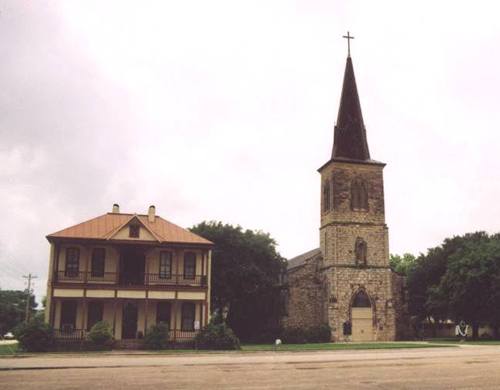 One
of the most notable of these was the very first church in Castroville (the first church in all of Medina County in fact)--the one hundred and thirty-seven year old St. Louis Catholic Church which was built by the early colonists. The church began as a small wooden building insisted upon by Henry Castro himself in Castroville’s early development. (Crook, 125)
One
of the most notable of these was the very first church in Castroville (the first church in all of Medina County in fact)--the one hundred and thirty-seven year old St. Louis Catholic Church which was built by the early colonists. The church began as a small wooden building insisted upon by Henry Castro himself in Castroville’s early development. (Crook, 125) 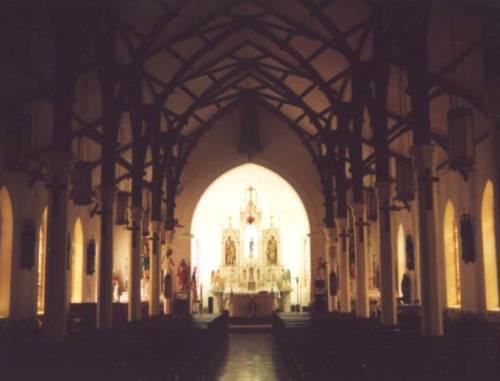 The Right Reverend Claude-Dubuis, a young priest sent from France to carry on the work of Catholicism in Castroville, persuaded some of the colonist’s men to build a larger and more solid building upon his arrival to Texas. (Crook, 125) On November 9, 1846, the Bishop Odin
The Right Reverend Claude-Dubuis, a young priest sent from France to carry on the work of Catholicism in Castroville, persuaded some of the colonist’s men to build a larger and more solid building upon his arrival to Texas. (Crook, 125) On November 9, 1846, the Bishop Odin 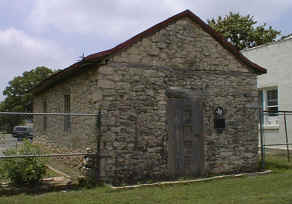 dedicated the small and frail building which was built from the available, local stones of Castroville. (Crook, 125) From its humble beginnings, the small church building, by the endeavors of Abbey Dubuis and Father Emmanuel Domenech, developed into the magnificent present-day church which was finished and completed on the Easter of 1850 (although the original building still stands beside the actual church). (Crook, 127) The Church, dedicated to the patron saint St. Louis IX of France, has stood as the pride of many Catholic Communities and was one of the first of ten parishes created in Texas. (History of Saint Louis Church) In 1970, the St. Louis Catholic Church officially became a historic Texas Landmark. (History of Saint Louis Church) Today, the church is often noted for its extremely tall spire, one that can be seen all around Castroville--a symbol and pride of the community.
dedicated the small and frail building which was built from the available, local stones of Castroville. (Crook, 125) From its humble beginnings, the small church building, by the endeavors of Abbey Dubuis and Father Emmanuel Domenech, developed into the magnificent present-day church which was finished and completed on the Easter of 1850 (although the original building still stands beside the actual church). (Crook, 127) The Church, dedicated to the patron saint St. Louis IX of France, has stood as the pride of many Catholic Communities and was one of the first of ten parishes created in Texas. (History of Saint Louis Church) In 1970, the St. Louis Catholic Church officially became a historic Texas Landmark. (History of Saint Louis Church) Today, the church is often noted for its extremely tall spire, one that can be seen all around Castroville--a symbol and pride of the community.
Another famous landmark in Castroville is, of course, the Landmark Inn! The Landmark Inn has a unique and diverse history. Originally, Cesar Monod, a Swiss merchant from Lavaca came to purchase land in Castroville seeing it as an opportunity for business. In about 1849, Monod built a small store/family residence in what was to become the first floor of the present-day  Landmark Inn. (“History,” 1) Because several people at the time were headed towards the gold mines in California, Monod’s store became a frequent stop for travelers. (“History,” 1) His store being located nearly in front of the san Antonio-El Paso Road, the location proved to be the ideal business location. In 1853 the store passed from Cesar Monod to Irish immigrant John Vance who purchased it from him. (“History,” 1) John Vance opened up a general store with this newly purchased property and eventually began to add to the prosperity that the area had brought to the previous owner. John built the Vance House in 1859 which would later serve the uses of the future Landmark Inn. Because of the store’s location on the heavily traveled road from San Antonio to Mexico and El Paso, John Vance built a second floor to accommodate travelers passing through while also providing them with supplies. During the Civil war, with the prosperity of the South’s cotton, many
Landmark Inn. (“History,” 1) Because several people at the time were headed towards the gold mines in California, Monod’s store became a frequent stop for travelers. (“History,” 1) His store being located nearly in front of the san Antonio-El Paso Road, the location proved to be the ideal business location. In 1853 the store passed from Cesar Monod to Irish immigrant John Vance who purchased it from him. (“History,” 1) John Vance opened up a general store with this newly purchased property and eventually began to add to the prosperity that the area had brought to the previous owner. John built the Vance House in 1859 which would later serve the uses of the future Landmark Inn. Because of the store’s location on the heavily traveled road from San Antonio to Mexico and El Paso, John Vance built a second floor to accommodate travelers passing through while also providing them with supplies. During the Civil war, with the prosperity of the South’s cotton, many 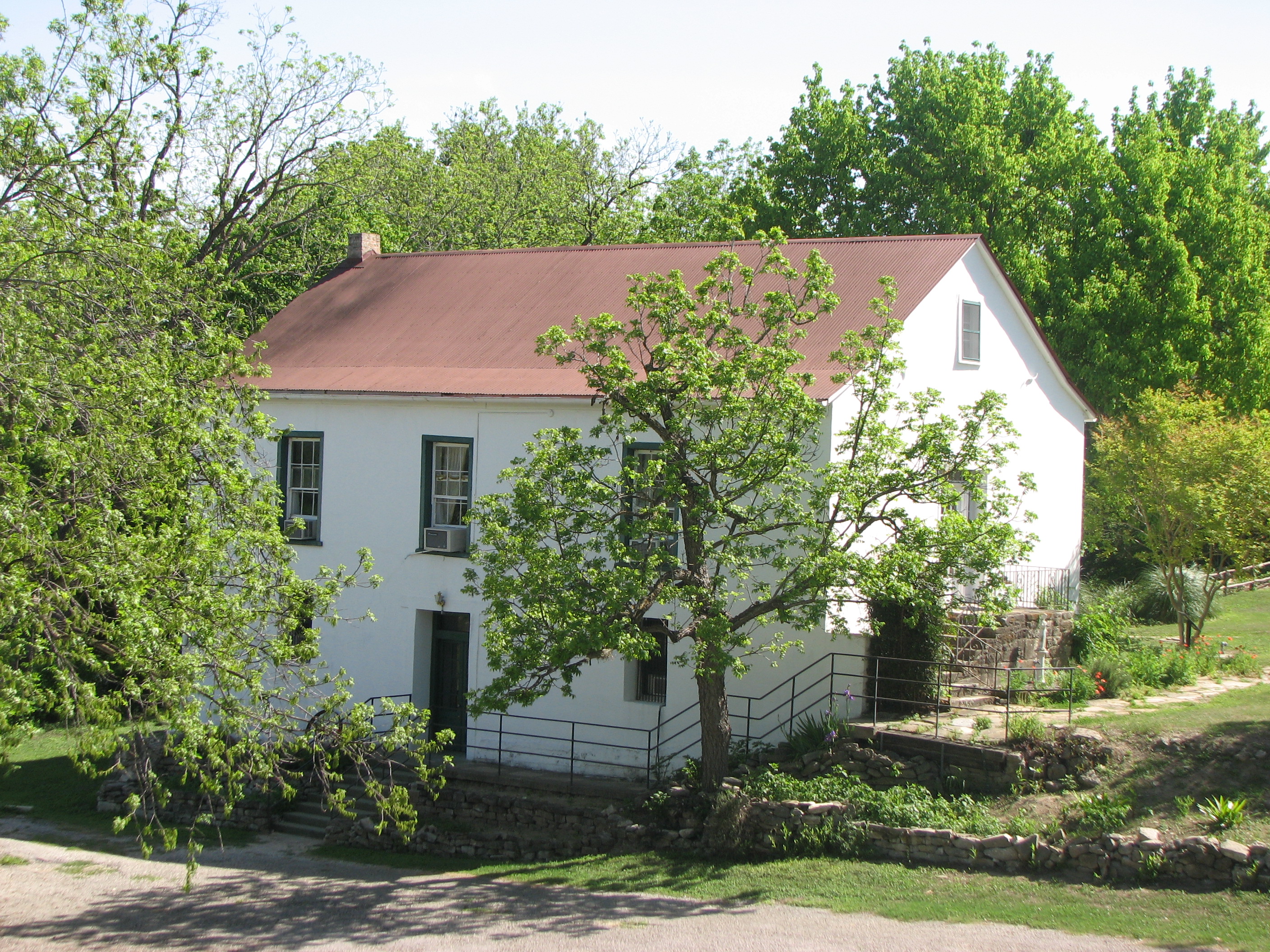 traders began to trade on the Mexican ports in order to bypass the Union blockade. Many of those same traders passed by Vance’s general store, which had become to be known as the Vance Hotel when the second floor was built in 1870’s. (“History,” 1) In 1853, Vance sold his property along the riverside to businessmen Haas and Quintle. (“History,” 1) They converted it into a custom grist mill and cotton gin, which in later years to come became very prosperous due to the growing agriculture economy of that area. (“History,” 1) In the 1860’s a man by the name of Joseph Courand purchased the property from Haas and Quintle, and then modernized the productions there (such as replacing the old water wheel with a turbine). (“History,” 1) A lumber mill was also added. However, in the 1900’s the cotton gin burned down, and in the 1920’s the property was purchased by J.T. Lawler. He converted the mill to generate electricity, bringing the very first lights to Castroville. (“History,” 1) The mill’s production closed down in 1935, but was brought back to life as the present-day Landmark Inn by J.T. Lawler’s sister, Ruth Lawler in 1940. (“History,” 1) Essentially, Ruth restored the main building to an Inn to accommodate the local military couples. Because of the Inn’s long and diverse history, the Landmark Inn stands today as a well-known landmark and still continues to operate till this day. Visitors can still visit this one-of-a-kind Bed & Breakfast and experience the old-fashioned hospitality and unique history of the Landmark Inn.
traders began to trade on the Mexican ports in order to bypass the Union blockade. Many of those same traders passed by Vance’s general store, which had become to be known as the Vance Hotel when the second floor was built in 1870’s. (“History,” 1) In 1853, Vance sold his property along the riverside to businessmen Haas and Quintle. (“History,” 1) They converted it into a custom grist mill and cotton gin, which in later years to come became very prosperous due to the growing agriculture economy of that area. (“History,” 1) In the 1860’s a man by the name of Joseph Courand purchased the property from Haas and Quintle, and then modernized the productions there (such as replacing the old water wheel with a turbine). (“History,” 1) A lumber mill was also added. However, in the 1900’s the cotton gin burned down, and in the 1920’s the property was purchased by J.T. Lawler. He converted the mill to generate electricity, bringing the very first lights to Castroville. (“History,” 1) The mill’s production closed down in 1935, but was brought back to life as the present-day Landmark Inn by J.T. Lawler’s sister, Ruth Lawler in 1940. (“History,” 1) Essentially, Ruth restored the main building to an Inn to accommodate the local military couples. Because of the Inn’s long and diverse history, the Landmark Inn stands today as a well-known landmark and still continues to operate till this day. Visitors can still visit this one-of-a-kind Bed & Breakfast and experience the old-fashioned hospitality and unique history of the Landmark Inn.

A lot of information for which the public could learn about Castroville can be found in Castroville’s public library which, in fact, is a landmark itself. Castroville public library was the very first public library to be introduced to Medina County (let alone the town itself!). The Castroville public library, interestingly enough, has access to great historical information concerning the town’s history (such as the ship list of the names of the people who came with Henry Castro to Texas). (Keller) The library began operation in 1963 and has been operating ever since. (Castroville Chamber of Commerce)
Along with Castroville’s diverse history and multiple landmarks are some of the most cherished festivals and events that still occur in Castroville today. One of these days of celebration (perhaps the most recognized) is Castroville’s St. Louis Day celebration. The celebration originated in 1882 as a small church homecoming, but eventually through the course of several years developed into the town holiday that it is today. (“History of Saint Louis Day”) It initially began as a feast celebration for the parish’s patron saint, Saint Louis IX of France. (“History of Saint Louis Day”) Since then, the local holiday has grown into the massive celebration it is today, celebrated by visitors from all over Texas and around the world; in fact, the celebration has been dubbed the “Homecoming for the State of Texas!” (“History of Saint Louis Day”) The celebration is a fun event held every year on the Sunday closest to the 25th of August. The “homecoming” essentially is celebrated much like a typical picnic but with an abundance of food and entertainment to go along with it. With all of its festivities and spirit in mind, Castroville’s St. Louis Day celebration is perhaps one of the most fantastic and most recognized festivals in Texas.

Castroville is a beautiful town which is nestled quietly beside the Medina River. The town’s unique historical significance establishes Castroville as a major tourist attraction. Simply put, Castroville is a great and unique place to visit. It is full of historical landmarks which are a welcome place for visitors all around Texas. Castroville is often noted for its preservation of its own history and perhaps is the only Texas town to have achieved such an endeavor so well. Because of the early colonists of Castroville, the town has a uniquely Alsatian style and feel to it. In fact, it is the only town in America that has influences from Alsace, France—in their building structures as well as in their community. The citizens of Castroville are a substantially “closely-knit” community; consequently, Castroville is a friendly and warm environment. (Keller) Interestingly, many of the older generations (descendents of the original Alsatian settlers) still speak the language of their ancestors. (Keller) According to Castroville resident Doris Keller, Castroville is definitely a community “on the grow,” evidenced by the multiple sub-divisions springing up and the recent population increases. (Keller) Places such as the Landmark Inn, St. Louis Catholic Church, and the town’s Regional Park make Castroville as diverse as it is in its own history. Because of its rich, unique history and heritage, Castroville has proven to be one of the most remarkable towns of Texas.
____________________________________________________________________________
Annotated Bibliography
Ochoa, Ruben E. “Castroville Texas.” The Handbook of Texas Online. 17 Jan 2008.
Although the article is somewhat short, the author of the work extensively elaborates on the history of Castroville. The work is informative accounting information from some of the town’s earliest history to the present. Many credible sources were used in this article, as well as the site being fairly credible itself. Because it is somewhat short, however, it leads one to question the scope of the information given.
Very little information is given here as to the history of Castroville. This site is used mainly as a public venue for tourist attractions and the such. This website offers current attractions and information to the general public. A link that leads to a very small article of the city’s history and heritage gives a couple of interesting facts but seemed insufficient for this project.
Hardly any information is given of Castroville’s history, but rather simple information on the small town’s current status. Also, given is records of population, educational information, and family ancestries. Not a very helpful source, as far as Castroville‘s history.
Unfortunately, this site was repetitive. The majority of the information used in the website’s history article was recycled information from the Handbook of Texas Online--being the main source (perhaps, single source) for the article. However, one can follow the side tabs to information such as town facts, historical sites, festivities, etc.
This book was exceptionally informative. A reliable source with many credible sources referenced within the text. In this book is given much detailed information on Henry Castro and the colonies he organized.
A very informative work on Henry Castro. This book effectively relays the events leading to the colonization of Castroville and the events following. However, the majority of this book merely elaborates on the history concerning Henry Castro and, subsequently, his colonies. Nevertheless, it still proves to be an informative work.
Obviously, only information is given about the church itself, but it was quite useful in that aspect. Much information about the landmark was gleamed from this site.
An exceptionally informative resource. Although it only spans about one-two pages, the ariticle is very informative and detailed. A great source for historical information on the Landmark Inn.
A uniquely informative website. The site is dedicated soley to information on the Castroville celebration. A long detailed article proved to be quite enlightening on the history of the special day. Very useful in that aspect.
A unique and special resource. It was very revealing and informative. I greatly enjoyed the experience and wish to express my gratitude to Ms. Doris Keller for her graciously-willing participation in the interview and her overall assistance to this particular project. Again, thank you so much!
Interview
Interview conducted by Andrew De La Rosa with Doris Keller on April 11, 2008
_______________________________________What is your Name?
Doris Keller
What educational level (if you feel appropriate) have you achieved?
A high school education
Do you have any siblings? If so, how many, and what are their names?
Yes, I have two brothers, and their names are Walter and Julian Stein.
Are you married? If so, what is the name of your spouse?
No I’m not married I am a widow. My husband’s name was Glenn Keller Senior.
Do you have any children? If so how many, and what are their names?
Yes, I have two boys one named Glenn Keller Jr. and the other Terry Wayne Keller.
What are the names of your parents? Walter and Tessie Stein
Are they originally from Castroville, Texas?
Yes, my mother was born in Devine and my Dad resided in the Cliff community (that’s what they called it).
Are you originally from Castroville, Texas?
Well, I was born in Rio Medina, which is basically the Castroville community.
How long have you lived in Castroville?
I’ve lived in Rio Medina ever since, although we did live in San Antonio for three years and, the day Kennedy was shot, we moved from San Antonio to Rio Medina.
Are you possibly related to anyone significant to Castroville’s history? If so, who was this person (and any additional information about him/her)?
Well, my husband’s uncle, Frank Keller, was president of the Castro State Bank.
What do you do in Castroville (what is your occupation)?
I am a librarian assistant at Castroville Public Library and have been for the past ten years. Before that I worked at the local newspaper as a columnist (Keller’s Korner) and retired in 1995 as society editor of the Castroville news bulletin and stayed home two months before becoming a librarian assistant.
What is the typical job here in Castroville?
The Medina Valley Independent School District.
What are some things that Castroville is known for?
Castroville is often noted for the preservation of Castroville’s heritage. An example would be the Castroville’s historic homes.
I heard there are some churches in Castroville with unique histories, are you aware of any of these churches , and do you attend any of them?
Yes, in particular I am a parishioner of St. Louis Catholic Church.
Are there any exciting or interesting events that occur in Castroville?
Certainly, there is the St. Louis Day Celebration, which is celebrated on the closest Sunday to August 25 every year.
(If you were there to experience it). Did you observe any type of racial segregation in Castroville?
Oh no, I would say that Castroville is actually a closely-knit community.
Do you know much about the unique history behind Castroville’s origins?
Yes, much of that information is available at the library.
I heard that there are still some descendants of the original Alsatian settlers, do you know (or are related to any) of these people?
Probably, there were a lot of names given on the ship list that came with Castro. That list in fact is available at the library as well.
Finally, is there anything you think I might need to know or anything you’d like to add?
Well, Castroville is definitely a community on the grow because sub divisions have been springing up recently and is still making room for even more. Even here in Castroville you can drive and see vacant lots being filled up because of the population explosion.
Back to Texas Small Town History Projects